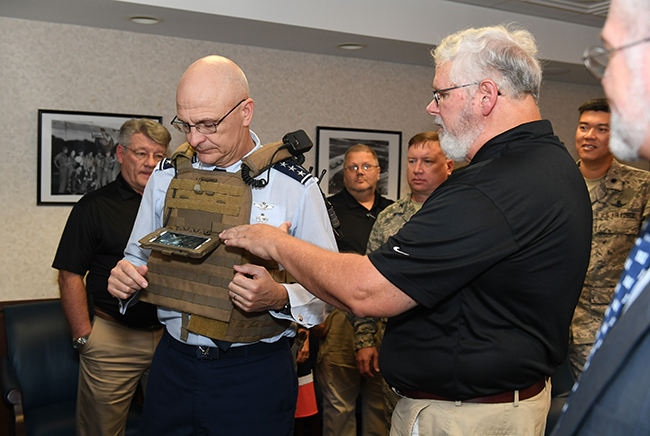
Gen. Arnold Bunch, then-military deputy in the Office of the Assistant Secretary of the Air Force for Acquisition, dons the Airborne Extensible Relay Over-the-Horizon Network concept combat tactical vest with the help of Steve Brown from the Tactical Data Network Laboratory at Hanscom AFB, Mass., on Sept. 26, 2018, during a tour of the Command, Control, Communications, Intelligence and Networks division. Air Force photo by Todd Maki.
As the Air Force revamps its approach to the high-profile light-attack experiment, it is beginning to tout another aspect of the program to partners and allies: AEROnet.
The Airborne Extensible Relay Over-Horizon Network, or AEROnet, is a prototype air-to-air and air-to-ground radio system that lets militaries share video, voice, and chat communications as well as command and control for less than $500,000. The Air Force developed it in tandem with the light-attack experiment so that all nations who invested in the new close air support program could share information more easily.
But AEROnet offers broader possibilities outside of light attack, officials argue.
“Think of the partner nations that wouldn’t necessarily be allowed to have Type 1 encryption, which is the encryption we have in Link 16 and things like that, but we still need to build our coalition,” Brig. Gen. Michael Schmidt, the Air Force’s program executive officer for command, control, communications, intelligence, and networks, said at a recent Air Force Life Cycle Management Center conference.
Developed by the Air Force Research Laboratory at Air Force Chief of Staff Gen. David Goldfein’s urging, Schmidt said the Air Force tested out the comms system at Finland’s Bold Quest exercise in May and shopped AEROnet around in South America at the end of June, Schmidt said.
“I’m sure there’s discussions of light attack going on, but we’re trying to separate AEROnet from light attack because they’re not necessarily one or the other,” Schmidt said. “AEROnet is an aerial networking capability that could be used on really any aircraft.”
AEROnet could be used in special operations forces’ efforts to bolster other nations’ militaries, Schmidt said. Air Combat Command chief Gen. Mike Holmes noted that if countries aren’t in the market for more expensive platforms, they aren’t looking for high-end communications networks either.
“What can we offer in a network that is exportable, that meets all the security requirements that can interlink people with each other and with us, that can take advantage of all the different communication systems that are out there already” Holmes said. “You’re offering a network that has airplanes, too, that fit in with it and not, here’s a big airplane, now go figure out how you’re going to talk to it and how you’re going to use it.”
AEROnet can run on smartphones and tablets and is comprised of commercially available parts that are more accessible to other countries than other military-specific components. It can also connect to other mobile technologies like the Android Tactical Assault Kit, a tablet-based mapping and communications tool spreading throughout the Air Force.
The service is now offering industry the opportunity to mass produce AFRL’s prototype, with a contract award due at the end of 2019. According to slides presented at the AFLCMC conference, the contract value was still undecided and the customer is potentially ACC, AFSOC, and “non-coalition partner nations.”
Holmes said AEROnet tests are ongoing and would continue as part of the light-attack program if the service buys those planes to replace more advanced assets in counterinsurgency missions. In May, the Air Force said it is working on a version of the network that can send data over the horizon.
The Air Force is marketing AEROnet as it pulls back on its initial plan to buy multiple squadrons of Sierra Nevada Corp.-Embraer A-29s or Textron’s AT-6, deciding to purchase a handful of planes to continue experiments rather than start broader production. The service said other countries weren’t sold on the two turboprop airplanes after two years of vetting, leading lawmakers to criticize how the Air Force has handled the program.
Holmes said he’s heard anecdotal international interest in using Boeing’s T-X training jet as a light-attack aircraft, but he noted the option isn’t right for everyone.
“Although you may be using the airplane to fight violent extremists in your own country, there’s also impact on your neighbors of what you possess and what other capabilities you have,” Holmes said. “You can make the case that some countries don’t need F-16s, they’d be better off with A-29, and yet the neighbors have F-16s and they have to think about how they fit in to both partner operations with their neighbors and also how they make sure that their neighbors know that they’re not a pushover.”
He added that ACC and Air Force Special Operations Command will present a path forward for the light-attack program to Goldfein this fall.